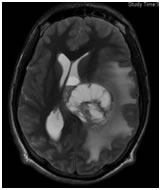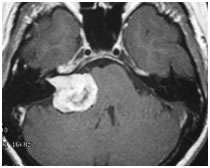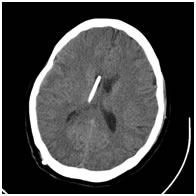 |
|
   |
|
| Home » Services » Brain Conditions | |||
Brain TumoursBrain tumours are comprised of a large group of varied lesions which present in different ways. The goals and recommendations for management are therefore quite individual. A diagnosis is sought first of all. Occasionally, MRI is sufficient to give a confident diagnosis, but tissue sampling at the time of surgery is usually necessary. This may be through a biopsy procedure or performed at the time of tumour resection. There has recently been significant progress in the genetic analysis of tumour samples in addition to the standard "microscopic" appearance to help make decisions about treatment. This is particularly true for "gliomas" and other "primary" tumours. The big two categories of brain tumours are primary (arising from brain tissue) and secondary (start outside the brain and travel to the brain). Some brain tumours are biologically benign. These tumours do not need post-operative treatments unless there is recurrence or potentially unstable pathology. Most primary tumours and the large majority of secondary tumours will require additional post-operative treatment: either radiotherapy, chemotherapy or both. The benefits of initial tumour resection include: accuracy of diagnosis, relief of direct and indirect pressure effects, potential cure and in many cases, the improvement in overall outcome by assisting the adjuvant post-operative treatments. Surgical planning and recommendations are of course highly individualized and depend on a large number of factors. Clinical and radiological evaluation will help determine the risk and benefits and therefore the appropriateness of surgery.
Glioma This a very broad term describing a group of tumours united by their origin from "glial" or supporting cells of the brain. They range from low grade and slow growing to high grade and faster growing. Management depends upon the type and grade of tumour as well as a large number of clinical factors. Tissue sampling is necessary to establish the diagnosis. Various subtypes include Astrocytoma, GBM (Glioblastoma Multiforme), Oligodendroglioma, Ependymoma, Medulloblastoma, Neurocytoma and Ganglioglioma. GBM (Glioblastoma Multiforme) This is the most common type of primary brain tumour and almost always requires surgery. Because the tumour is intrinsic and grows along nerve fibres, it is not usually possible to cure. Instead, as much of the accessible tumour is removed as it is safe to do. Post operatively, radiotherapy and chemotherapy are given. Genetic testing of the tumour is also very helpful in determining best treatment. Low Grade Glioma A low grade glioma is usually a slow growing lesion with a characteristic MRI and CT appearance. Treatment remains controversial and ranges from observation only, to biopsy or resection. Meningioma These tumours begin outside the brain and usually slowly push the brain away. They have a characteristic appearance on MRI and CT. Surgery is recommended when there is enlargement on serial imaging, symptoms related to the tumour or uncertainty with the diagnosis. The surgery is usually straight forward, depending on accessibility and they are often effectively cured. Long term MRI surveillance is however recommended.
Acoustic Neuroma These are a special type of tumour with a higher degree of complexity and may occur as part of an inherited syndrome. The tumour arises from the balance and hearing nerve itself and as a result, commonly presents with hearing loss. This tumour is also closely associated with the nearby cranial nerves and may cause compression and dysfunction of the underlying brainstem. Treatment decisions depend upon a large number of factors but range from observation and serial monitoring, surgical excision or debulking, or stereotactic radiation treatment. Metastasis (Cancer) When a primary tumour spreads from its site of origin, it is commonly carried by the blood stream. The brain is a prominent site for secondary deposits and these tumours have a characteristic appearance on MRI. They often cause substantial brain swelling. If the primary site is not known or one or more lesions are symptomatic and accessible, then surgical removal is usually recommended. Pituitary Tumours Pituitary tumours are a specific group of lesions that are situated under the visual apparatus (optic nerves). When there is sufficient enlargement, they may present with visual disturbance by compressing the optic nerves or chiasm from below. They also commonly present with hormonal imbalances called endocrinopathy, either from too much or too little of a specific hormone. Because of their midline location immediately behind the nose, they are easily accessible with minimally invasive approaches if it comes to surgical intervention.
HydrocephalusHydrocephalus refers to a problem with the normal circulation of "CSF" through the central chambers of the brain and around the special fluid plains around the brain. It leads to a build of fluid and / or pressure intracranially, which can result in a number of neurological problems, including headache, walking problems and difficulty with cognitive performance (thinking and memory). Occasionally, the cause is a blockage within the fluid chambers, which blocks from the inside, but more often, no discrete blockage is seen and the problem is in the spaces surrounding the brain or with fluid absorption. The most common way to treat this problem is with a "ventriculperitoneal shunt", but in some cases a "third ventriculostomy" will effectively bypass a central blockage. I prefer to use a programmable device called the Strata valve, which can be adjusted to fine tune flow. Chiari MalformationsThe Chiari Malformations describe a group of developmental disorders resulting in abnormal positioning of the "hind brain". The most common type is a type 1 lesion, where part of the balance structure called the cerebellum is situated too low. This leads to compression of the underlying brainstem and secondary fluid build up problems. When it is symptomatic or there are obvious pressure problems, surgical intervention is recommended. The goal of surgery is to create sufficient room at the site of blockage to address the brain compression and to prevent further build up of fluid pressure. TraumaTrauma can result in a wide range of neurosurgical problems. Occasionally, the trauma is so trivial that there is no recollection of the actual event. The most common problem that needs treatments is a "subdural haematoma". If there are pressure effects on the brain or symptoms from the distortion, then surgery is recommended. The recommended intervention ranges from a simple burr hole to removal of the clot through a larger craniotomy. |
 |
© Dr Jonathan Curtis MBBS, FRACS, Neurosurgeon, Spine and Endovascular Greenwich NSW |
|
| Home | Disclaimer | Privacy | Sitemap | Feedback | Tell a friend | Contact Us |


